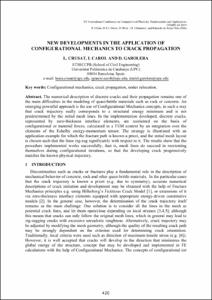Mostra el registre d'ítem simple
New developments in the application of configurational mechanics to crack propagation
| dc.contributor.author | Crusat Codina, Laura |
| dc.contributor.author | Carol, Ignacio |
| dc.contributor.author | Garolera Vinent, Daniel |
| dc.contributor.other | Universitat Politècnica de Catalunya. Departament d'Enginyeria Civil i Ambiental |
| dc.date.accessioned | 2020-03-24T16:23:35Z |
| dc.date.available | 2020-03-24T16:23:35Z |
| dc.date.issued | 2019 |
| dc.identifier.citation | Crusat, L.; Carol, I.; Garolera, D. New developments in the application of configurational mechanics to crack propagation. A: International Conference on Computational Plasticity. "COMPLAS 2019: XV International Conference on Computational Plasticity: Fundamentals and Applications". 2019, p. 420-426. |
| dc.identifier.isbn | 978-84-949194-7-3 |
| dc.identifier.uri | http://hdl.handle.net/2117/181169 |
| dc.description.abstract | The numerical description of discrete cracks and their propagation remains one of the main difficulties in the modeling of quasi-brittle materials such as rock or concrete. An emerging powerful approach is the use of Configurational Mechanics concepts, in such a way that crack trajectory really corresponds to a structural energy minimum and is not predetermined by the initial mesh lines. In theimplementationdeveloped, discrete cracks, represented by zero-thickness interface elements, are reoriented on thebasis of configurational or material forces, calculated in a FEM context by an integration over the elements of the Eshelby energy-momentum tensor. The strategy is illustrated with an application example for which the fracture path is known a priori, and the initial mesh layout is chosen such that the lines zig-zag significantly with respect to it. The results show that the procedure implemented works successfully, that is, mesh lines do succeed in reorienting themselves during configurational iterations, so that the developing crack progressively matches the known physical trajectory. |
| dc.format.extent | 7 p. |
| dc.language.iso | eng |
| dc.subject | Àrees temàtiques de la UPC::Enginyeria civil::Materials i estructures |
| dc.subject.lcsh | Fracture mechanics--Mathematical models |
| dc.subject.other | Configurational mechanics |
| dc.subject.other | Crack propagation |
| dc.subject.other | Nodes relocation |
| dc.title | New developments in the application of configurational mechanics to crack propagation |
| dc.type | Conference report |
| dc.subject.lemac | Mecànica de fractura -- Models matemàtics |
| dc.contributor.group | Universitat Politècnica de Catalunya. MECMAT - Mecànica de Materials |
| dc.relation.publisherversion | https://congress.cimne.com/complas2019/frontal/Doc/EbookCOMPLAS2019.pdf |
| dc.rights.access | Open Access |
| local.identifier.drac | 27030799 |
| dc.description.version | Postprint (published version) |
| local.citation.author | Crusat, L.; Carol, I.; Garolera, D. |
| local.citation.contributor | International Conference on Computational Plasticity |
| local.citation.publicationName | COMPLAS 2019: XV International Conference on Computational Plasticity: Fundamentals and Applications |
| local.citation.startingPage | 420 |
| local.citation.endingPage | 426 |


